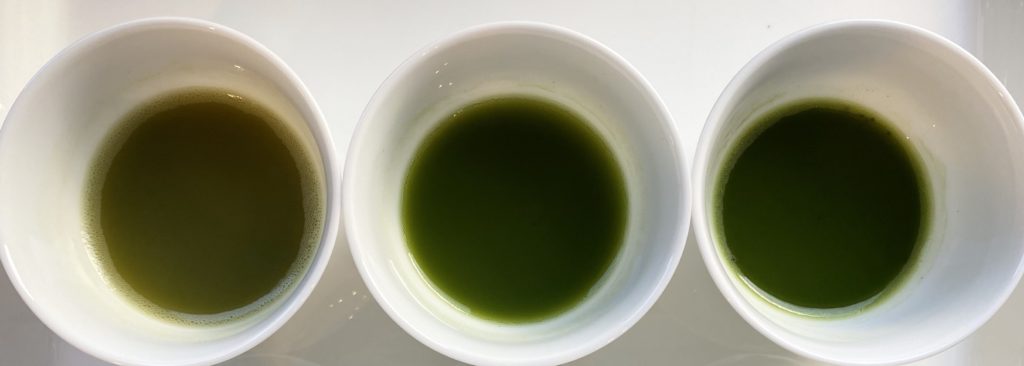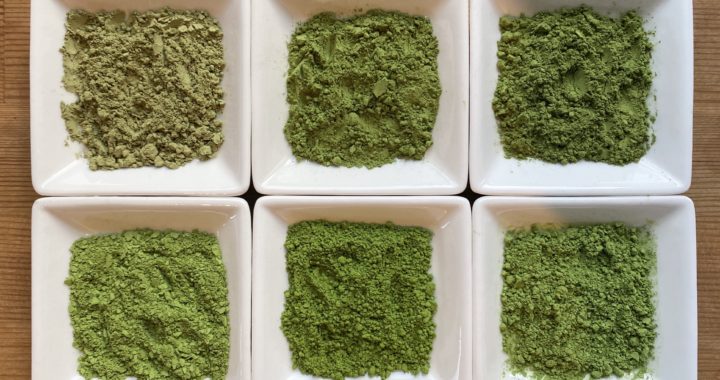May it be for baking, cooking, making drinks (anything that comes to your mind!) — doesn’t it ever make you wonder “Hmm, which Matcha should I use?”. At the Obubu house, it is a common question when we are up to something.
Before we go through how our taste test went, let us first give a little information on the matcha powders used in this article. Among our Kitchen-Grade Matcha powders, we have the Basic Grade, Excellent Grade, and the Premium Grade. But we won’t stop there! We also have three Ceremonial Grade Matcha powders of different cultivars: Samidori, Okumidori, and Gokou.
Note: Although the kitchen grade Matcha is not intended to be drank pure (in the same manner you often would with Ceremonial Grade Matcha) we tried to be fair with all the powders and took notes on the taste profile of each. We sure did have a caffeine rush in the evening!
“Why does it matter which one I use?” “I’ll just go with the finest one.” “It’s all the same anyway.” Well friends, hold your thoughts! We’ve made a guide which would hopefully be of some help (with the interns’ perspective).
Kitchen-grade Matcha Powders

Left to right: basic, excellent, premium
Basic Grade Matcha
Taste: Astringent
Harvest: October
Cultivar: Yabukita
Cultivation: Unshaded
Color: Dull Green
Thoughts: It is the most economical among all the Matcha powders so it is recommended for large-scale food production. As it is unshaded compared to the rest, the tea bushes receive more sunlight (and formation of cathechins) resulting to a more bitter flavor profile. It would be good to use in recipes for cooking and baking where you combine Matcha with other flavors. As it has a strong presence of bitterness, it would be a good option to mix it in recipes wherein you’d be able to balance the the flavors, but still get that unique Matcha flavor pop out.
Excellent Grade Matcha
Taste: Astringent
Harvest: July
Cultivar: Yabukita
Cultivation: Shaded
Color: Green
Thoughts: Harvested in summer from unshaded tea bushes, this Matcha is a versatile option for cooking, baking, and also making beverages. It is perhaps the middle ground of not being too bitter, and easy to incorporate in a recipe. I’d say it is closer in terms of quality with the Premium Grade Matcha — just slightly less richer in taste, with a less vibrant (but distinct) green color.
Premium Grade Matcha
Taste: Astringent
Harvest: July
Cultivar: Yabukita
Cultivation: Shaded
Color: Bright Green
Thoughts: The Premium Grade Matcha is a high quality stone-ground Matcha, harvested during summer from shaded tea bushes. This Matcha is perfect if you are making some kind of latte wherein it would taste great without any need to add any sweetener at all since the bitterness is very subtle. It is also versatile in cooking, with its rich Matcha flavor coming through, minus the astringency heavily present in the basic grade. Color-wise, it is more vibrant than the excellent and basic grades — very ideal for anything you make in the kitchen.
Now, let’s also go through the three Ceremonial grade Matcha powders.
Ceremonial Grade
Matcha is made from ground tea leaves and is favored for its rich flavor and deep green color. Unlike Kitchen-Grade Matcha, Ceremonial Grade Matcha is typically harvested in Spring from young and tender leaves for that sweet, umami flavor. The tea bushes are shaded for 3-4 weeks before harvesting and being processed into Tencha. Using a stone mill, Tencha is then ground into fine tea powder. This type of Matcha is meant to be enjoyed pure so you could enjoy the different characteristics of each cultivar.
Tea cultivars (cultivated variety) are bred by farmers by selecting favorable characteristics in a tea plant. Some are meant to adapt easily to different climates (such as Yabukita), and some are bred for its distinct flavors.
Ceremonial Grade Matcha powders are processed in the same manner, but because of the cultivar, the flavor profiles widely differ. While it is visually similar with its vivid green color, we’ve taken some quick notes on our personal thoughts on the three Matcha varieties.

Up-left to right: basic, excellent, premium Down-left to right: samidori, okumidori, gokou
Samidori
The Samidori Matcha has a sweet aroma and a smooth mouthfeel. It has this rich umami taste, light sweetness, and some chocolate notes. Almost no bitterness is present in this Matcha.
Okumidori
The Okumidori is perfect for someone in search for a balanced taste. It is rich, smooth, and has delicate sweetness. You’ll find just the right amount of umami, with almost no bitterness as well. This would be a great cultivar to introduce to someone who is new to Matcha, or to those who are not fond of the bitter notes commonly present in Matcha.
Gokou
As compared to the the other two, Gokou is rich and feels very creamy and thicker. It feels as though the Matcha grips onto your tongue and although it has a hint of bitter taste, it is not unpleasant at all. It is somehow grassy and ‘green’. If someone were to imagine how Matcha would taste like, the Gokou Matcha would be close to what we’d have in mind.
—
Of course, taste is subjective. When it comes to comparing which one is better among the ceremonial grade variants, all of these are produced with the finest quality. Similar with the cooking grade Matcha, I would say that it is difficult to say which one is better since they have their own strengths and a lot of factors (such as use and taste preference) must be taken into consideration. Simply put, the best way to find out which suits your tastebuds is to simply try for yourself. The Sampler Set we have (available for the Drinking Matcha and the Cooking Matcha Powders) is nice way to have a bit of everything for your own tea discovery.
We’d love to hear from you, though! What is your Matcha match?
You may want to check out recipes made by our previous interns as well.
-Mikie


Voilà qui est super intéressant, merci !